Exhibit - Building
Introduction
The Center of the City
The Mob has Entered the Building
Beyond the Mob
Becoming The Mob Museum
THIS BUILDING OF OURS

The Mob Museum tells the story of organized crime and law enforcement through immersive exhibits and artifacts. But it also preserves an important piece of Las Vegas history.
Details
Introduction

The building that houses The Mob Museum began as the first federal structure in Las Vegas, built in 1933. The former U.S. Post Office and Courthouse is one of the city’s oldest buildings. It is also a great representation of neoclassical architecture, a popular style in its era for federal buildings.
Details
A Historic Building

The building was the setting for a pivotal event in organized crime history. In 1950, the U.S. Senate’s Kefauver Committee held a hearing in the courtroom to question individuals about organized crime in Las Vegas. It is largely because of this significant event that the building was added to the National Register of Historic Places in 1983. But this is just one part of the building’s rich history.
Details
A Federal Courthouse for Las Vegas

The town of Las Vegas was established in 1905 as a stop along the San Pedro, Los Angeles and Salt Lake Railroad. Railroad officials drew up a 40-block townsite and auctioned lots in what is now downtown Las Vegas.
Details
The Early Days

By the 1920s, the city had grown up around the railroad depot, but with no federal building, Las Vegans had to travel more than 400 miles to Nevada’s capital, Carson City, for hearings and trials. Southern Nevadans lobbied for a federal building of their own.
Details

Las Vegas eventually settled on the city fairgrounds as the location.
Details
Block 16
The proposed location for the building was a short distance from Block 16, the city’s vice district, and Block 17, where many members of the Black community lived and worked. Federal construction engineer John Lammers objected to the site because, in his words, it was in “an undesirable part of the city.” The site was selected after the city promised to shut down Block 16. (This did not actually happen until World War II.
Details
Plains Construction of Texas

The federal government awarded the construction contract to Plains Construction of Texas. Shortly after breaking ground, locals noticed the building’s foundation was 32 feet off center. Experiencing financial setbacks, Plains Construction abandoned the project, and Rosen & Fischel Inc. of Chicago picked up where it left off.
Details
Treasures of the Past

During the building’s restoration in the early 2000s, a construction crew found this gin bottle hidden in a wall on the building’s second floor, untouched since the original construction. Prohibition ended in December 1933, a month after the building’s dedication.
Details
Court Is in Session
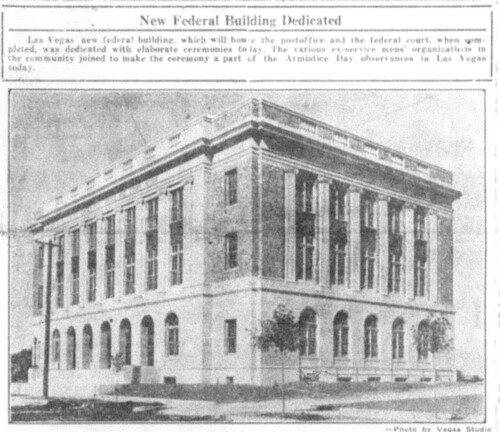
On November 11, 1933, the building was dedicated. Veterans’ organizations boosted the event by including it in their Armistice Day observations.
For the first few years, judges from California and Carson City traveled to Las Vegas to hold hearings and trials.
Details
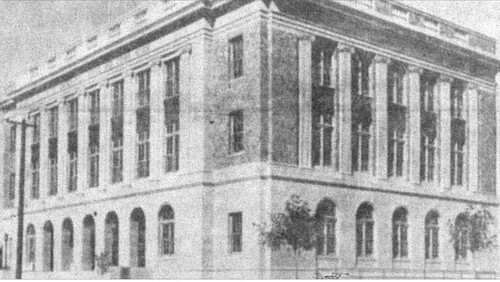
At the first court session in the building, presiding Judge Paul McCormick of Los Angeles said:
“The building and courtroom are a credit to the genius of the engineering persons who brought it into being … It is dignified and elegant. … It is hoped that justice may always prevail here.”
Details
Judge Roger T. Foley
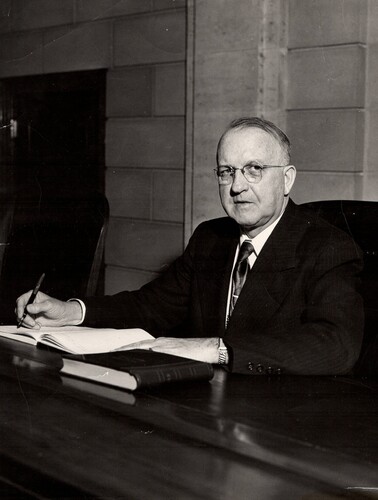
In 1945, Judge Roger T. Foley became Las Vegas’s first full-time federal judge and served until 1974. His son Roger D. Foley also served as a judge in the building. In 1967, a new federal courthouse opened to handle the growing city’s needs. It was later named the Foley Federal Building, after the Foley family.
Details
The Center of the City

Las Vegans frequented the building as a one-stop shop for civic needs. From money orders and mailboxes to gardening guides and hunting licenses, the federal building was a part of daily life in the city.
Details
The First Tenant

The federal building’s first tenant was the post office. Frank Garside served as postmaster general of Clark County for 20 years. Garside also co-owned the Las Vegas Review-Journal with A.E. Cahlan until 1949.
Details
Growing Needs
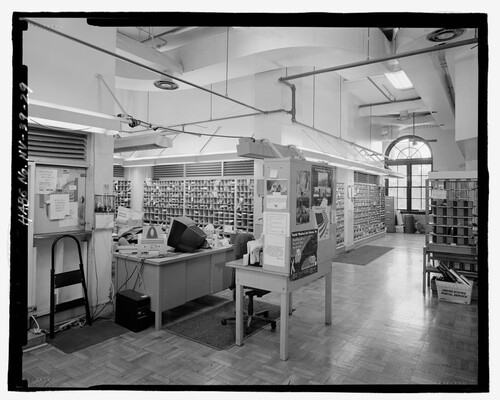
The post office continued to operate into the early 2000s. By the 1940s and ’50s, however, the volume of mail began to overwhelm the staff. Las Vegas was quickly outgrowing the federal building.
Details
The First Woman Called to Jury
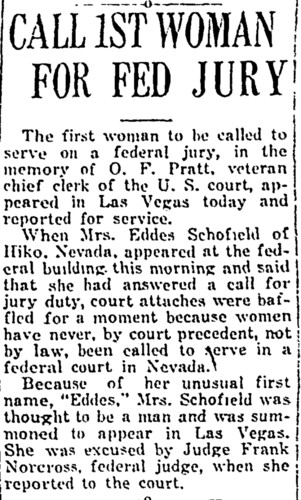
In 1935, Eddes Schofield traveled more than 100 miles to appear on a federal jury in Las Vegas. Unfortunately, the summons was in error because she “was thought to be a man.” She would have been the first women to serve on a federal jury in Nevada.
Details
The Actual First Woman Juror
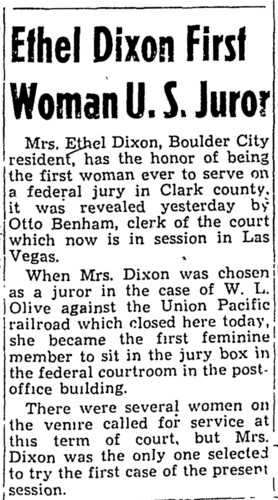
Ten years later, Ethel Dixon became the first woman to sit on a federal jury in Clark County. This time it was intentional.
Details
The Center of Civic Activity
As Las Vegas grew, the federal building became a center of civic activity. The IRS, Marshal Service, FBI, Social Security Administration, Small Business Administration, Department of Agriculture and Bureau of Land Management all had offices inside. It was also where many new citizens took their oath of allegiance.
Details
The Kim Sisters Take the Oath

In 1968, the Kim Sisters became U.S. citizens in the federal building. The Korean-born singing trio had been popular performers on the Las Vegas Strip for nearly a decade. Before the ceremony, Judge Roger D. Foley met with the sisters and “revealed quietly that he was a fan of theirs and played all their records."
Details
Military Recruitment
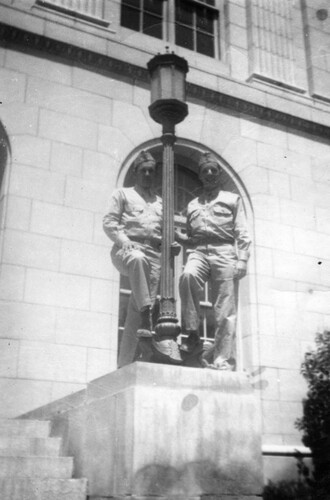
The federal building was home to military activity, boosted by World War II. Individuals interested in joining the Army or Navy went to recruiting stations there. The Army Airfield, which would later become Nellis Air Force Base, set up offices in the building while waiting for the new base to be constructed.
Details
THE MOB HAS ENTERED THE BUILDING

In the 1950s and ’60s, the building hosted a number of organized crime-related hearings and trials. On November 15, 1950, when Senate Estes Kefauver, standing, brought a special U.S. Senate committee to Las Vegas to investigate organized crime. From 1950-51, the Kefauver Committee visited many U.S. cities to hear testimony related to organized crime.
Details
The Lieutenant Governor Testifies

Kefauver speaks with Nevada Lieutenant Governor Clifford Jones, right, who was called as a witness before the committee. Jones was a part owner of the Thunderbird, Golden Nugget and Pioneer Club. The committee’s chief counsel, Rudolph Halley, asked Jones about Meyer Lansky, the Jewish mobster who allegedly was a secret financier of the Thunderbird.
Details
Gus Greenbaum Does Not
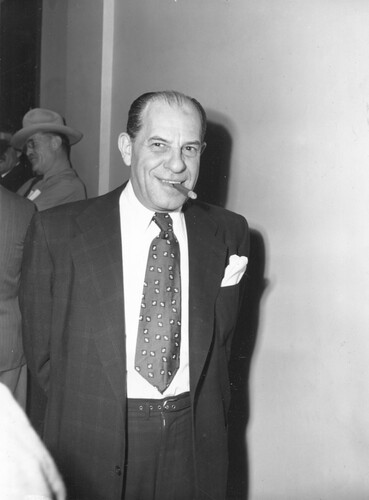
Gus Greenbaum, who oversaw the Flamingo with other mobsters, was subpoenaed by the Kefauver Committee but was not called into the courtroom.
Details
Moe Sedway Takes the Stand

His partner, Moe Sedway, did testify. Sedway prefaced his testimony by listing his health problems, including three major coronary thromboses, ulcers and a six-week spell of diarrhea.
Details
Kefauver Condemns Nevada
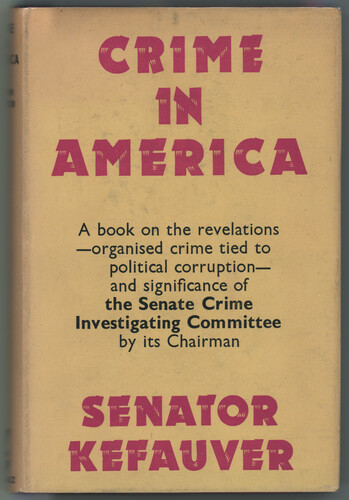
Senator Kefauver wrote a book, Crime in America, summarizing the committee’s findings. In a chapter on Las Vegas, Kefauver wrote a scathing indictment of Nevada’s gaming industry.
“As a case of legalized gambling, Nevada speaks eloquently in the negative.”
The Kefauver Committee had an unintentional effect on Las Vegas. The committee was successful in motivating gambling crackdowns across the country, which drove more organized crime to Las Vegas as mobsters across the country invested in the only place where casinos were legal.
Details
Local Criticism

Some Nevadans were displeased with Kefauver’s conclusions about the state. Following Kefauver’s visit, A.E. Cahlan, owner of the Las Vegas Review-Journal, criticized the committee in his column:
"And yet he and his colleagues just took a passing glance at actual conditions and then burst out all over the place with opinions extremely uncomplimentary to the whole people of this state."
Details
Benny Binion
Kefauver was only the beginning for the federal building’s Mob encounters.
Binion’s Gambling Hall & Hotel on Fremont Street, a few blocks from the federal building, is named for Benny Binion, a Dallas gambling kingpin who operated casinos in Las Vegas. Binion faced some of his legal troubles in the federal courthouse in 1951.
Details
Johnny Marshall Fights the Black Book

In 1960, Nevada created the Black Book, or List of Excluded Persons, which banned certain individuals associated with organized crime from owning, operating or even setting foot in Nevada casinos. Chicago mobster “Johnny Marshall,” whose actual name was Marshall Caifano, challenged his Black Book ban in 1963, claiming it violated his constitutional rights, but he lost the case. The trial was held in the federal courthouse.
Details
Attorney Oscar Goodman
Before he was Las Vegas mayor, Oscar Goodman was a defense attorney. He represented several individuals associated with organized crime, including Meyer Lansky, Tony Spilotro and Frank "Lefty" Rosenthal. His first federal case took place in the building.
Details
BEYOND THE MOB

The excitement in the courthouse wasn’t just from the Mob. Other events in and around the federal building added to its rich history.
Details
Hank Greenspun
Hank Greenspun, owner of the Las Vegas Sun, was involved in two high-profile cases in the courtroom. He first sparred with Senator Pat McCarran and Later with Senator Joseph McCarthy, infamous for his anti-communist crusade.
Details
The Moulin Rouge

Five months after it opened in 1955, the first racially integrated hotel-casino in Las Vegas, the Moulin Rouge, closed its doors. Its bankruptcy hearings were held inside the federal building. Representing the hotel, attorney Tom Foley, a son of Judge Roger T. Foley, said its “financial woes were the result of unexpected construction costs, which found the enterprise costing nearly twice as much as planned.” In 1956, a creditors meeting had to be moved out of the building because its 400 creditors far exceeded the courtroom’s capacity and overflowed out onto the street.
Details
A Foiled Mail Heist
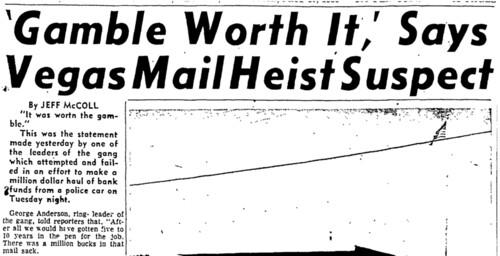
In 1955, a group of six schemed to commit what would have been, at the time, one of the biggest mail heists in U.S. history. Led by George Anderson, the gang planned to rob a police car picking up a mail shipment of bank funds containing at least $1 million. The police car was to be stopped and robbed beside the federal building. The plot was foiled when one of its members, former Henderson police officer Ed Meagher, informed federal authorities about the scheme. His five co-conspirators were arrested. Three, including Anderson, were later found guilty of “conspiracy to rob the United States mail.”
“We could have made the heist and been home free,” Anderson said. “We could have buried the money out in the desert, maintained our ‘respectability’ in Las Vegas, and then, when the heat was off, could have quietly left town."
Details
Sinatra Subpoenaed

After the new federal building opened in 1967, the old building continued to hold tax trials and grand jury hearings. In 1967, singer Frank Sinatra testified before a grand jury investigating allegations of casino skimming. Four years earlier, Sinatra had forfeited his gaming license after he allowed Chicago Mob boss Sam Giancana, who was in Nevada’s Black Book, into his Cal-Neva Lodge at Lake Tahoe.
Details
A Sinatra Sighting
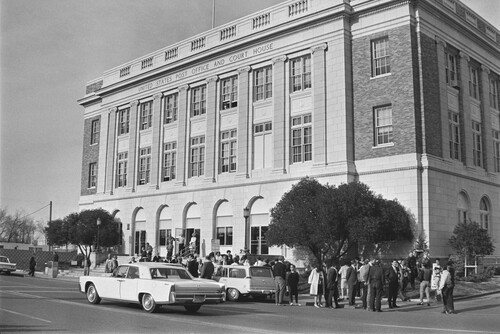
About 200 people crowded around the building hoping to get a glimpse of “Ol’ Blue Eyes.” Rather than face the hoard, Sinatra snuck out through a basement door, where a car waited for him out back.
Details
Becoming The Mob Museum

By the end of the 20th century, after most agencies had moved on, the federal building was looking for a new purpose. This important relic of Las Vegas history had to be preserved.
Details
Changing Needs

As agencies transitioned to the Foley Federal Building and other locations, the old courtroom continued to be used for tax trials and grand jury hearings. For efficiency, a partition divided the courtroom into two smaller rooms. The colorful interior designs were also painted over.
Details
National Register of Historic Places

In 1983, the federal building was added to the National Register of Historic Places, a program that promotes efforts to preserve America’s historic properties.
Details
Neighboring Landmarks

In 1973, the 11-story Las Vegas City Hall was constructed down the street from the federal building. When a new City Hall building opened in 2012, the online shoe retailer Zappos leased the old building for its new headquarters.
Details
Mayor Goodman Envisions a Museum
When Oscar Goodman became mayor in 1999, the view of the building from his office spurred him to give it a new purpose.
Details
Ellen Knowlton Chairs Inaugural Board
To assure residents that the new museum would present a balanced history of organized crime and law enforcement, Goodman recruited Ellen Knowlton, the recently retired special agent in charge of the FBI’s Las Vegas Field Office, to chair the museum’s inaugural board.
Details
Restorations Begin

Work on the museum began in 2011. One of the goals was to restore the courtroom to the way it looked when the Kefauver Committee held its hearing there in 1950. This meant removing the partitions.
Details
Original Walls Revealed
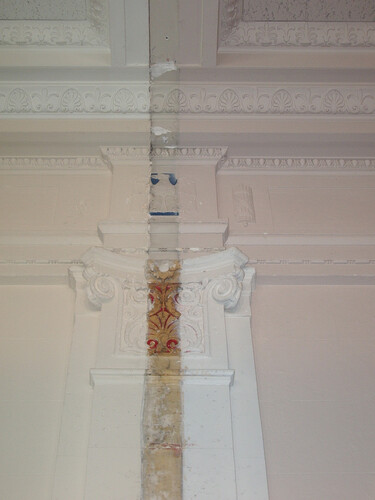
After removing the partition, the walls revealed the room’s original paint colors. In addition, the historical light fixtures that had been removed or damaged were re-created
Details
The Restored Historic Courtroom
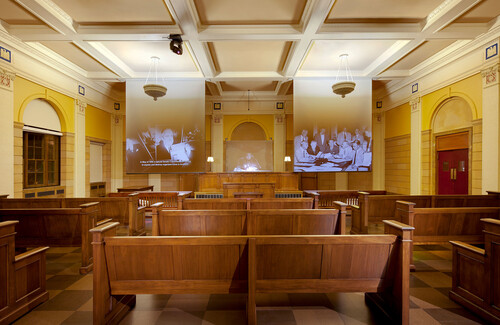
Once restoration was complete, the courtroom was back to its 1950 look. The original judge’s and clerk’s benches remained at the front of the room, and the tables and benches were also original to the building.
Details
The Mob Museum Opens

While the building was being renovated, the city hired curators Dennis and Kathie Barrie to lead development of museum exhibits chronicling the story of organized crime and law enforcement in America. On February 14, 2012, the Mob Museum opened with Mayor Oscar Goodman presiding over the festivities.
Details
For more information about the rich history of the US. Courthouse and Post Office,
watch our documentary This Building of Ours: The Story of a Las Vegas Landmark

This exhibit received generous financial support from the Commission for the Las Vegas Centennial.
This project is funded by the sales of the Las Vegas License Plate.






